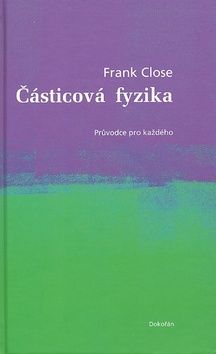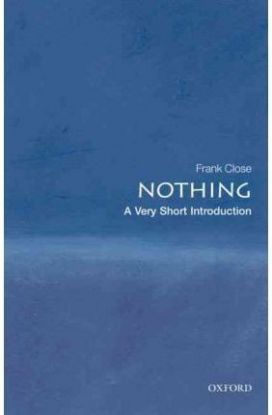Close Frank
autor
Částicová fyzika
Kniha je působivým průvodcem po fundamentálních částicích, z nichž je stvořen vesmír. Nechává nás nahlédnout do fascinujícího světa aktuálních objevů částicové fyziky a ukazuje, jak tyto objevy mění naše chápání světa. Podíváme se do nitra atomu, seznámíme se s kvarky, elektrony nebo tajemným neutrinem. Nechybí ani pátrání po antihmotě a diskuse o počtu dimenzí vesmíru.
Vypredané
8,00 €
8,42 €
Nothing: A Very Short Introduction (Very Short Introductions)
What is 'nothing'? What remains when you take all the matter away? Can empty space - a void - exist? This Very Short Introduction explores the science and the history of the elusive void: from Aristotle who insisted that the vacuum was impossible, via the theories of Newton and Einstein, to our very latest discoveries and why they can tell us extraordinary things about the cosmos. Frank Close tells the story of how scientists have explored the elusive void, and the rich discoveries that they have made there. He takes the reader on a lively and accessible history through ancient ideas and cultural superstitions to the frontiers of current research. He describes how scientists discovered that the vacuum is filled with fields; how Newton, Mach, and Einstein grappled with the nature of space and time; and how the mysterious 'aether' that was long ago supposed to permeate the void may now be making a comeback with the latest research into the 'Higgs field'. We now know that the vacuum is far from being empty - it seethes with virtual particles and antiparticles that erupt spontaneously into being, and it also may contain hidden dimensions that we were previously unaware of. These new discoveries may provide answers to some of cosmology's most fundamental questions: what lies outside the universe, and, if there was once nothing, then how did the universe begin? Nothing: A Very Short Introduction was first published in hardback as The Void.
Vypredané
11,09 €
11,67 €
Trinity
'Everything about this story is astounding' Bryan Appleyard, Sunday Times
"Trinity" was the codename for the test explosion of the atomic bomb in New Mexico on 16 July 1945. Trinity is now also the extraordinary story of the bomb's metaphorical father, Rudolf Peierls; his intellectual son, the atomic spy, Klaus Fuchs, and the ghosts of the security services in Britain, the USA and USSR.
Against the background of pre-war Nazi Germany, the Second World War and the following Cold War, the book traces how Peierls brought Fuchs into his family and his laboratory, only to be betrayed. It describes in unprecedented detail how Fuchs became a spy, his motivations and the information he passed to his Soviet contacts, both in the UK and after he went with Peierls to join the Manhattan Project at Los Alamos in 1944. Frank Close is himself a distinguished nuclear physicist: uniquely, the book explains the science as well as the spying.
Fuchs returned to Britain in August 1946 still undetected and became central to the UK's independent effort to develop nuclear weapons. Close describes the febrile atmosphere at Harwell, the nuclear physics laboratory near Oxford, where many of the key players were quartered, and the charged relationships which developed there. He uncovers fresh evidence about the role of the crucial VENONA signals decryptions, and shows how, despite mistakes made by both MI5 and the FBI, the net gradually closed around Fuchs, building an intolerable pressure which finally cracked him.
The Soviet Union exploded its first nuclear device in August 1949, far earlier than the US or UK expected. In 1951, the US Congressional Committee on Atomic Espionage concluded, 'Fuchs alone has influenced the safety of more people and accomplished greater damage than any other spy not only in the history of the United States, but in the history of nations'. This book is the most comprehensive account yet published of these events, and of the tragic figure at their centre.
Vypredané
28,45 €
29,95 €
Elusive
The story of the Higgs boson - the so-called 'God particle' - and the man who thought of it
In the summer of 1964, a reclusive young professor at the University of Edinburgh wrote two scientific papers which have come to change our understanding of the most fundamental building blocks of matter and the nature of the universe. Peter Higgs posited the existence an almost infinitely tiny particle - today known as the Higgs boson - which is the key to understanding why particles have mass, and but for which atoms and molecules could not exist.
For nearly 50 years afterwards, some of the largest projects in experimental physics sought to demonstrate the physical existence of the boson which Higgs had proposed. Sensationally, confirmation came in July 2012 at the Large Hadron Collider at CERN in Geneva. The following year Higgs was awarded the Nobel Prize for Physics. One of the least-known giants of science, he is the only person in history to have had a single particle named for them.
This revelatory book is 'not so much a biography of the man but of the boson named after him'. It brilliantly traces the course of much of twentieth-century physics from the inception of quantum field theory to the completion of the 'standard model' of particles and forces, and the pivotal role of Higgs's idea in this evolution. It also investigates the contested history of Higgs's responsibility for the breakthrough when there were others close by, and explains why the boson is named for him alone. Competition between institutions and states, Close shows, then played as much of a role in creating Higgs's fame as his work itself. Drawing on conversations with Higgs over a decade (a figure generally as elusive as his particle) this is a superb study of a scientist and his era - and of how scientific knowledge advances.
Vypredané
30,35 €
31,95 €
Elusive
The story of the Higgs boson - the so-called 'God particle' - and the man who thought of it
In the summer of 1964, a reclusive young professor at the University of Edinburgh wrote two scientific papers which have come to change our understanding of the most fundamental building blocks of matter and the nature of the universe. Peter Higgs posited the existence an almost infinitely tiny particle - today known as the Higgs boson - which is the key to understanding why particles have mass, and but for which atoms and molecules could not exist.
For nearly 50 years afterwards, some of the largest projects in experimental physics sought to demonstrate the physical existence of the boson which Higgs had proposed. Sensationally, confirmation came in July 2012 at the Large Hadron Collider at CERN in Geneva. The following year Higgs was awarded the Nobel Prize for Physics. One of the least-known giants of science, he is the only person in history to have had a single particle named for them.
This revelatory book is 'not so much a biography of the man but of the boson named after him'. It brilliantly traces the course of much of twentieth-century physics from the inception of quantum field theory to the completion of the 'standard model' of particles and forces, and the pivotal role of Higgs's idea in this evolution. It also investigates the contested history of Higgs's responsibility for the breakthrough when there were others close by, and explains why the boson is named for him alone. Competition between institutions and states, Close shows, then played as much of a role in creating Higgs's fame as his work itself. Drawing on conversations with Higgs over a decade (a figure generally as elusive as his particle) this is a superb study of a scientist and his era - and of how scientific knowledge advances.
Vypredané
17,05 €
17,95 €







